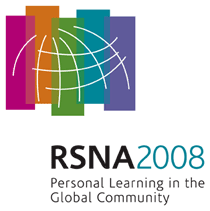
Abstract Archives of the RSNA, 2008
LL-MK4324-B08
Radiologist Radiation Exposure in CT Fluoroscopy-guided Procedures: Impact of Radiation Protection Devices on Scattered Radiation Exposure—Bicentric Prospective Study on 160 Consecutive Patients
Scientific Posters
Presented on November 30, 2008
Presented as part of LL-MK-B: Musculoskeletal
Hugues Brat MD, Presenter: Nothing to Disclose
Tarik Bouziane MD, Abstract Co-Author: Nothing to Disclose
Damien Delhaye MD, Abstract Co-Author: Nothing to Disclose
To evaluate impact of individual and combined radiation protection devices according to dose protocols on scattered radiation exposure of the radiologist during CT fluoroscopy (CTF) guided interventional procedures.
Two experienced radiologists working on different systems (Toshiba Aquilion 64 & Asteion, 4, Siemens Emotion 6 & Sensation 64) performed 160 consecutive CTF guided procedures (71 epidural, 68 periradicular, and 21 facet infiltrations). Both radiologists performed 80 procedures on each system. After each series of 10 procedures, scattered radiation exposure of the radiologist was measured on 22 detectors (left and right index, wrist, forearm, arm and leg , thyroid, chest, eye). Impact of individual and combined radiation protection devices such as lead gloves, needle holder, facial screen and patient lead cover was evaluated in all patients using simultaneously detectors taped on the inner and outer device surface. Scattered dose reduction (SDR) comparing 80 kV to 120 kV dose protocols was also evaluated.
Scattered dose reduction (SDR) of lead gloves ranges from 30% (fingertips) to 50% (wrist).The use of a facial lead screen enables a SDR of 94 % for the upper chest and head. A lead cover on the patient offers a 97% SDR for the lower part of the body. Combined use of radiation protection devices with 80 kV instead of 120kV protocols offers an overall SDR of 78% to the radiologist. Highest scattered dose exposure was at right hand with a mean exposure of 15.6µSv per procedure (1.88-67.81). Absence or presence of combined radiation protection devices as well as low dose protocols allow to perform repectively from 600 to 30.000 basic procedures / year.
Scattered dose to the radiologist performing CTF guided procedures is significantly reduced when combining all radiation protection devices and 80kV dose protocols.
Combined use of radiation protection devices and 80kV protocols in CTF guided procedures are mandatory to reduce radiologists x-ray exposure during interventions.
Brat, H,
Bouziane, T,
Delhaye, D,
Radiologist Radiation Exposure in CT Fluoroscopy-guided Procedures: Impact of Radiation Protection Devices on Scattered Radiation Exposure—Bicentric Prospective Study on 160 Consecutive Patients. Radiological Society of North America 2008 Scientific Assembly and Annual Meeting, February 18 - February 20, 2008 ,Chicago IL.
http://archive.rsna.org/2008/6014395.html

